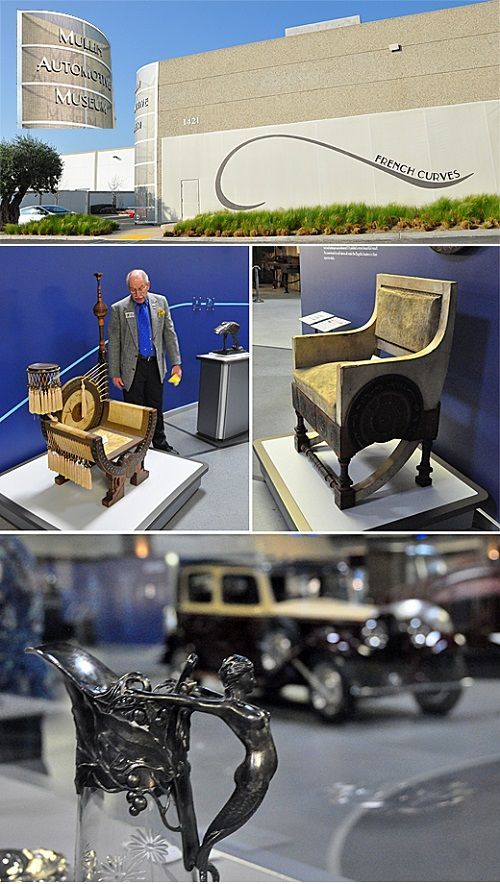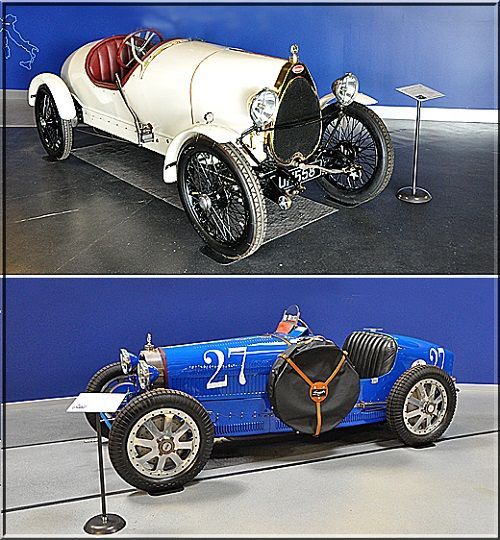Article
The Mullin Museum and its Art Deco Tribute to Bugatti
Author(s):
The Mullin Museum offers a car lover's dream, but it's much more than a car museum. It's more of an "Art Deco museum with cars as a centerpiece."
The question automobile journalists have to ask themselves when they discover a jewel of a car museum like the Mullin is, How much detail can non-car enthusiasts endure? How much technical information can readers suffer? And would car buffs want even more data and less anecdotes? Writers have to wing it and hope for the best. The challenge is particularly difficult if a museum is dedicated to a foreign car made at its peak of fame about a century or so ago.
Enter Bugatti.
Peter W. Mullin, a Californian financial services entrepreneur and philanthropist has long been a car buff. He indulged his passion when Otis Chandler, the publisher of the Los Angeles Times, died in 2006 and Mullin was able to buy and renovate the building in Oxnard, California where Chandler had housed his vintage automobile collection. Mullin further added to and refined his car collection when he bought from the widow of Fritz Schlumpf most of the 62 cars still left in that part of the famous Schlumpf Reserve Collection that had not been involved in the 20-year lawsuit by the French government. It’s a long story not really relevant for most Mullin Museum visitors yet for details click here.
When you come into this gorgeous automotive museum the first thing you see, of course, is …furniture! The museum, though specializing in expensive vintage cars—mostly Bugattis—is a tribute to “French Curves” and the Art Deco charm of the Bugatti family.

The museum. Docent Rick Eberst, who is also a college professor, draws our attention to some of Carlo Bugatti’s ornate furniture that shows the delightful cabriolet French Curves, much like son Rembrandt’s silverware.
So you see elegant furniture, ornate bronze sculpture, and beautiful silverware. This is surprising but Mullin has been quoted as saying, “Our museum is really not a car museum so much as it is an Art Deco museum with cars as a centerpiece.” It’s also a tribute to art of the talented Bugatti family: the patriarch Carlo, an Italian who moved to Paris with his wife and family about a century ago. (More than 40 pieces of Carlo’s decorative furniture are on display.) His elder son with the interest in building cars was Ettore and Carlo’s younger son Rembrandt was a talented sculptor whose animal statues were inspired by his visits to the Antwerp Zoo in Belgium.

We move on from Carlo’s cabinetmaker’s results to Ettore’s early cars. The 1913 Peugeot Bebe Cabriolet. Ettore designed this single-cylinder Bebe Peugeot but because business was slow at that time he licensed the 4-cylinder car to Peugeot in 1911. It was based on his own Type 13 model of 1910.
Many stories about Ettore Bugatti circulate, a favorite being how a wealthy business man had a problem with his Type 57 and sent his car back to the factory several times with no improvement. He finally took it in person saying he would wait there himself to get satisfaction. He had hung around the factory for days when a door opened into the corridor where he was pacing and the Great Bugatti himself came out. The customer hastened towards him.
Etorre Bugatti then spoke. “Are you the customer who keeps sending the Type 57 back to us for over-heating?’” he asked.
“Yes, yes,” the customer hurried to say, hope rising in his chest. Said Bugatti, “Don’t let it happen again!” and went back to his office.

Above 1908 Bugatti Type 10 (the first Bugatti ever built)
Bottom 1920 Bugatti Type 13 Brescia Two-Seater
The first car Bugatti ever produced was the lightweight racing car he built in his basement (in Cologne, Germany). It is now called the 1908 Bugatti Type 10. It weighed a mere 704 pounds and reached 49 mph with its 4-cylinder 1100cc engine. The 4-cylinder 1920 Bugatti Type 13 Brescia Two-Seater (on loan from Mrs Gary Byrd) came with a weight of 900 lbs with first 8, then 16 valves. With 8 valves it came second at Le Mans in 1911 and in 1921 in the Brescia Grand Prix it swept the first top 4 places to forever have the name Brescia added to its identity. Brescia in northern Italy was the start and end of the celebrated Mille Miglia.

Above 1922 Bugatti Type 23 Brescia Two-Seater
Bottom 1925 Bugatti Type 35C Grand Prix
The 1922 Bugatti Type 23 Brescia Two-Seater on show at the Mullin has been around. It was built in Alsace on the French-German border and sent to the company show room in Paris. It was then bought in 1925 by a wealthy Irishman who moved it to Londonderry in Northern Ireland. It was discovered in Belfast in 1949 and restored then bought by British Bugatti historian Hugh Conway who kept it till 1971. It moved around Europe under different owners for several years until Peter Mullin bought it in Germany in 2008. Around this time Americans were being encouraged to buy new cars every 2 years even as Europeans claimed a well-built car with 100,000 miles on it was barely broken in. Bugatti’s cars were getting bigger: the inline 4-cylinder now was 1,496cc.
Yes the cars were getting bigger. The 1925 Bugatti Type 35C Grand Prix started as a 35A the first of the type 35A cars to be imported to England. Converted and restored by enthusiasts its inline 8-cylinder engine now was 1,991cc.

The famous Bugatti Type 41 Royale Coupe De Ville
Insert: The elephant rampant motif created by Rembrandt
Bugatti was selling upscale cars now although his timing was terrible—the Great Depression was approaching. He showed the Type 41 at the 1928 Paris Auto Salon as the most expensive car ever built. The Bugatti Royale got its name because Bugatti would not make the Royale, at this time the most expensive car in the world, for anyone except Royalty. Says Rick Eberst, “When Bugatti heard the King of Albania wanted to have Bugatti build him a Royale, Bugatti said of the King, “No! I would never sell to him. He has terrible table manners.”
There are stories about how this car was born. Bugatti was taking a lady friend to dinner at Maxim’s in Paris when she remarked his cars were modest compared to Rolls-Royce which at that time cost 190,000 French Francs. Perhaps he was provoked because the first Type 41 Royale sold cost the customer 780,000 French Francs. It was massive: 21 feet long weighing 7,000 pounds with a 12.7 liter 300 HP engine. Only 6 Bugatti Royals were ever built. The one on display here is on loan from Volkswagen.

Above 1929 Bugatti Type 46 Semi-Profile
Bottom 1932 Bugatti Type 55
The Bugatti Type 46 Semi-Profile is gorgeous. It’s easy to imagine the Great Gatsby driving it. This the first of the 16 Bugattis of the Type 46 chassis was sold to the physician in charge of the sanatorium in Vinohrady, Prague, Dr. Vladimir Boruvka. The coachbuilder who added the sleek body in 1934 loved his design so much he bought it back from the doctor 3 years later! In this era customers often bought the chassis and engine and went to a coachbuilder to finish off the vehicle. It had an inline 8-cylinder, 5,359cc, 140 HP engine.
The 1932 Bugatti Type 55 offers quite a contrast. A straight 8-cylinder 2,262cc 130HP completely Bugatti-built roadster, the first car Ettore’s son Jean designed. He was aged 22!
There are sad stories in the Bugatti family: Rembrandt took his own life in 1916 and Ettore’s son, Jean, died in a car crash in 1939 aged 30, testing and refining the Type 57C tank racer that had won the 24 Hours Le Mans. He was swerving to avoid a drunken bicyclist and, hitting a tree, died instantly.

Above 1939 Bugatti Type 64 Coupe
Middle image the 1936 Bugatti Type 57SC Atlantic that won the 2003 Pebble Beach Concours. There are only 2 such cars in the world—and Ralph Lauren has the other (it won the 1990 Pebble Beach Concours). Bottom 1994 Bugatti EB 110 Supersport “Le Mans” Insert Sculpture Rene Dreyfus in a Bugatti Type 51
The1939 Bugatti Type 64 Coupe has a complicated story that is discussed here fully. When Jean died he left a chassis that had not yet been fitted with a body. After the chassis won an award in the 2002 Pebble Beach Concours d'Elegance, Mullin bought it and challenged Stewart Reed and his students at the Art Center College of Design in Pasadena, Calif., to come up with a body. On display is the result.
The 1936 Bugatti Type 57SC Atlantic was once owned by New Hampshire neurologist, Peter D. Williamson, MD, a pioneer in evaluating patients for epilepsy surgery. Peter Mullin bought that Bugatti for what The Wall Street Journal of May 4, 2010 says was more than $30 million. It is now considered to have a greater value than the Bugatti Royale.
The 1994 Bugatti EB 110 Supersport “Le Mans” was created by an Italian entrepreneur who resurrected the Bugatti brand in 1987. He gave the turbo V12 with a top speed 216 mph a price tag of $450,000 just as the recession of the early 1990s arrived. The company went bankrupt even though 7-time Formula One World Champion Michael Schumacher bought an EB110SS while racing for Ferrari.
If you are obsessionally interested in cars click here for info on the main Schlumpf collection now called the French National Automobile Museum. To learn how part of the Schlumpf escaped from its French government lawsuit click here. For even more details click here. To read about car collecting as a possible investment, click at this page and also here. And finally to get a well written piece by a writer Michael Taylor that really sums up the whole complicated story click here for his Hemmings blog.
Photography by the authors courtesy of the Mullin Automotive Museum
The Andersons, who live in San Diego, are the resident travel & cruise columnists for Physician's Money Digest. Nancy is a former nursing educator, Eric a retired MD. The one-time president of the New Hampshire Academy of Family Physicians. Eric is the only physician in the Society of American Travel Writers and in the Los Angeles-based Motor Press Guild, the largest automotive media association in North America. He has also written 5 books, the last called The Man Who Cried Orange: Stories from a Doctor's Life.




